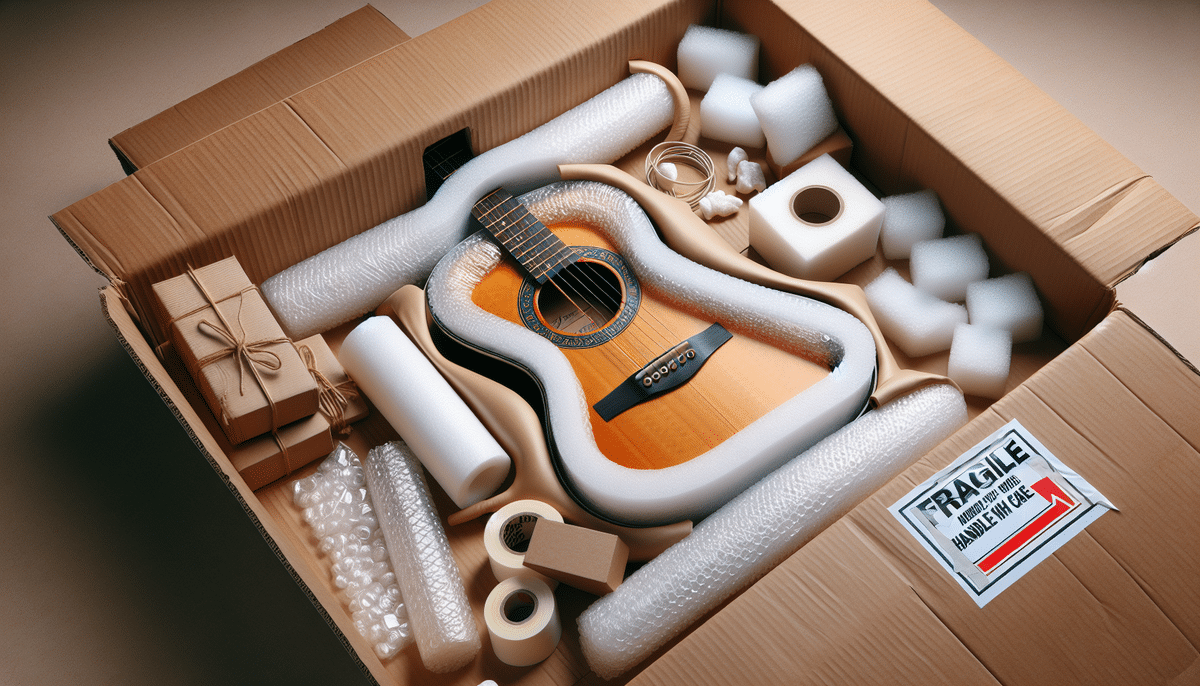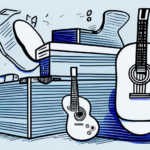How to Safely Ship a Guitar: A Step-by-Step Guide
Shipping a guitar can be a nerve-wracking experience, especially if you're sending one with significant sentimental or economic value. Fortunately, with proper preparation and execution, you can ensure that your guitar arrives at its destination safely and securely. In this step-by-step guide, we'll go over everything you need to do to safely ship your guitar, from choosing the right box to protecting fragile components. So, let's get started!
Why Proper Packing is Important When Shipping Guitars
The first thing to understand is why proper packing is so critical when shipping a guitar. Guitars are delicate instruments, and a lack of proper protection can cause severe damage during transit, including cracks, scratches, and even breakages. Additionally, guitar shipments are often subject to rough handling during transport, which means that packing your instrument correctly is the only way to safeguard it from these risks.
According to a study by the Musical Instruments Shipping Association, over 30% of guitar shipments experience some form of damage due to inadequate packing. This highlights the importance of following best practices to minimize risks.
Another reason why proper packing is important when shipping guitars is to ensure that the instrument arrives at its destination in the same condition it was in when it was shipped. This is especially important for vintage or rare guitars, which can be worth a significant amount of money. Proper packing can also prevent any damage to the guitar's finish, which can affect its sound quality and overall value. Therefore, taking the time to pack your guitar correctly can save you a lot of money and hassle in the long run.
Choosing the Right Box for Shipping Your Guitar
The first step in safely shipping your guitar is choosing the right box. The ideal box for guitar shipments should be sturdy and durable, able to withstand the usual bumps and knocks associated with shipping. Additionally, it should be appropriately sized, so the guitar doesn't move around inside it. For acoustic guitars, a hard-shell case can be the best box option as they are sturdy and offer added protection.
When packing your guitar, it's important to use proper cushioning materials to prevent any damage during transit. Bubble wrap, foam, or packing peanuts can be used to fill any empty spaces in the box and provide extra protection. It's also recommended to loosen the strings slightly to relieve tension on the neck and prevent any potential damage. Lastly, make sure to label the box as fragile and include any necessary shipping instructions to ensure safe delivery.
The Best Materials for Packing Your Guitar
The next step is to gather all the necessary materials to pack your guitar securely. This includes:
- Bubble Wrap: Provides excellent cushioning around delicate parts.
- Packing Peanuts or Foam Blocks: Helps keep the guitar from shifting during transit.
- Packing Tape: Essential for sealing the box securely to protect your guitar from dust, moisture, and any potential damage.
- Climate-Controlled Packaging: Recommended for high-value instruments to prevent damage from temperature and humidity fluctuations.
According to industry best practices, using a combination of these materials significantly reduces the risk of damage. For larger guitars, such as dreadnoughts or jumbos, you may need to use a double-walled box for added protection. Additionally, if you're shipping your guitar internationally, you may need to include customs forms and additional documentation.
It's also a good idea to label your package as "Fragile" and include arrows indicating which side should be facing up. This helps ensure that your guitar is handled with care during transit. Lastly, choose a reputable shipping carrier with experience in handling musical instruments to ensure that your guitar arrives safely at its destination.
How to Disassemble Your Guitar for Shipping
Disassembling your guitar can further protect it during shipment. Here's how to do it:
- Loosen the Strings: Prevents undue tension on the neck during transport.
- Remove Accessories: Take out any picks, capos, or other accessories to prevent them from scratching or damaging the guitar's finish.
- Remove the Neck: Carefully detach the guitar's neck and pack it separately to avoid stress on the instrument.
- Pack Electronics Separately: For electric guitars, remove and pack components like the pickguard and electronics separately.
Using a sturdy, double-walled box that is slightly larger than your guitar is crucial for secure packing. Wrap your guitar in bubble wrap or foam padding, and secure it with packing tape. Fill any empty spaces in the box with packing peanuts or more padding to prevent the guitar from shifting during transport. Label the box as "Fragile" and include arrows indicating which end should be up. With these steps, your guitar should arrive at its destination safely and in one piece.
How to Securely Pack Each Component of Your Guitar
Securing each component of your guitar individually can enhance protection during shipping:
- Guitar Body: Wrap firmly with bubble wrap and place it in the box. Add packing peanuts or foam blocks to keep it stable.
- Guitar Neck: Wrap in bubble wrap and place it in a separate box or a long tube, ensuring it is well-cushioned.
- Headstock and Bridge: Wrap these parts separately, especially in acoustic guitars, to prevent damage.
- Strings and Accessories: Loosen the strings and use a small piece of foam or tissue paper to protect them. Wrap accessories like pedals or cables individually and place them in a separate box.
Labeling the boxes clearly with "Fragile" and "This Side Up" stickers ensures that the package is handled with care during transit. Consider purchasing insurance to protect your instrument in case of any damage or loss during shipping. By taking these extra precautions, you can ensure that your guitar arrives safely and securely at its destination.
Tips for Protecting the Guitar Neck and Headstock
The guitar neck and headstock are particularly vulnerable during transit, so it's crucial to take extra care when packing them. Here are some tips:
- Use Foam Blocks: Add a foam block around the headstock inside the guitar case to prevent movement or bumps during shipping.
- Bubble Wrap: Wrap the headstock and neck with bubble wrap to protect them from scratches and dings.
- Neck Boxes: Consider using a neck box designed for shipping guitar necks for added protection.
- Loosen the Strings: Reduces tension on the neck and prevents potential damage.
- Remove Accessories: Take out any loose items from the guitar case to prevent them from scratching or damaging the neck and headstock.
- Climate Control: Use a climate-controlled shipping container or add a humidifier to the guitar case to maintain a consistent environment, preventing wood expansion or contraction due to temperature and humidity changes.
Maintaining a stable environment during transit is essential, as extreme temperatures and humidity can cause the wood to expand or contract, potentially damaging the neck and headstock. Taking these steps will help ensure the integrity of your guitar's neck and headstock upon arrival.
How to Safely Ship Electric Guitars
Shipping electric guitars requires additional precautions due to their unique shape and components. Here are the key steps:
- Remove the Strings: Prevents tension stress on the neck during transit.
- Wrap Pickups and Bridge: Use bubble wrap to protect these sensitive components.
- Detach and Pack Detachable Parts: Remove components like tremolo systems or strap buttons and pack them separately to avoid damage.
- Use a Hard-Shell Case: Place the case in a larger shipping box and add extra cushioning to prevent any movement or jostling.
It's also important to consider the weather conditions during shipping. Extreme temperatures can damage the guitar's finish or even cause warping. If you're shipping during the winter or summer months, it's recommended to use a climate-controlled shipping service. Additionally, make sure to label the package as "Fragile" and include clear instructions for the carrier on how to handle the package with care.
According to ShipScience's guidelines, these additional steps are crucial in maintaining the condition of electric guitars during transit.
How to Safely Ship Acoustic Guitars
Acoustic guitars require specific handling since they have a hollow body, making them more susceptible to damage. Here are the best practices:
- Loosen the Strings: Eases any tension on the guitar's neck and body.
- Protect the Soundhole: Add extra padding around the soundhole to prevent damage.
- Use Extra Cushioning: Place additional cushioning under the guitar body to absorb bumps and knocks during shipping.
- Secure the Case: Ensure the guitar case is locked and reinforced before packing.
Using high-quality packing materials and ensuring the guitar is securely positioned within the box will help prevent damage to the hollow body and maintain the instrument's integrity.
How to Label Your Guitar Package Correctly
Proper labeling on your guitar package is essential, as it can help ensure the smooth and safe handling of your instrument while in transit. Follow these tips for effective labeling:
- Recipient Information: Clearly write the recipient's name, address, and contact details on the box.
- Fragile Indicators: Write "FRAGILE" in large, bold letters to alert carriers to the delicate nature of the package.
- Shipping Information: Add any shipping information, such as tracking numbers, order numbers, or shipping service details, to track the shipment if needed.
- Handling Instructions: Include arrows indicating which side should be facing up to ensure proper handling.
Proper labeling reduces the risk of mishandling and helps the carrier understand the importance of treating your package with care.
The Best Carriers for Shipping Your Guitar
When choosing a carrier to ship your guitar, opt for a reputable and reliable service that specializes in the shipping of musical instruments. Here are some top choices:
- UPS: Offers specialized instrument shipping services and has a reputation for reliability.
- FedEx: Provides tailored shipping solutions for musical instruments, including additional insurance options.
- USPS: While offering basic shipping services, USPS can be a cost-effective option with proper packaging.
- ShipScience: Specializes in musical instrument shipping and offers customized packaging and insurance options.
Additionally, you can purchase additional insurance to cover the value of your guitar in case of loss or damage while in transit. Reviewing each carrier's specific services and comparing their prices and protections will help you choose the best option for your needs. For more details, visit ShipScience's shipping services.
What to Do If Your Guitar Gets Damaged During Shipping
If your guitar sustains damage while in transit, take immediate action by following these steps:
- File a Claim: Contact the shipping carrier as soon as possible to file a damage claim.
- Document the Damage: Take clear photographs of the damage and keep all packaging materials as evidence.
- Professional Assessment: Have your guitar assessed by a professional luthier to determine the extent of the damage and obtain an estimate for repairs.
- Follow Up: Maintain communication with the carrier regarding the status of your claim.
According to the FedEx policy, timely filing and thorough documentation increase the likelihood of a successful claim. Ensuring that you have adequate insurance coverage before shipping can also simplify this process in case damage occurs.
Insurance Options for Shipping Your Guitar
Protecting your guitar with insurance is crucial, especially for valuable or rare instruments. Here are your options:
- Carrier-Provided Insurance: Most carriers offer additional insurance coverage for high-value items. Review the policy carefully to understand coverage limits and exclusions.
- Third-Party Insurance: Companies like ShipScience Insurance offer policies specifically designed for musical instruments, often providing more comprehensive coverage than carrier-provided options.
- Homeowner’s Insurance: Some homeowner’s insurance policies may cover items in transit, but it's essential to verify this with your provider.
Ensuring that your chosen insurance covers all potential risks, such as damage, loss, and theft, will give you peace of mind during the shipping process.
How to Track Your Shipment and Ensure Safe Delivery
Keeping track of your shipment is essential to ensure the safe delivery of your guitar. Here's how to effectively track and confirm your shipment:
- Use Tracking Services: Choose a carrier that offers tracking services to stay updated on your shipment's location and expected delivery date.
- Share Tracking Information: Provide the recipient with the tracking number so they can monitor the shipment's progress.
- Confirm Delivery: Ask the recipient to confirm the shipment's arrival upon delivery to ensure that your guitar has arrived safely.
- Set Delivery Notifications: Enable delivery notifications or alerts to stay informed about the status of your shipment in real-time.
Some carriers also offer signature confirmation, which requires the recipient to sign upon delivery, providing an additional layer of security. Utilizing these tracking and confirmation methods can help ensure that your guitar arrives at its destination in top condition.
By following these essential steps, you can safely ship your guitar and ensure it arrives at its destination in top condition. Remember that proper preparation and handling are key to safeguarding your valuable guitar investment, so don't hesitate to take extra steps to protect it during transit. Happy shipping!






















